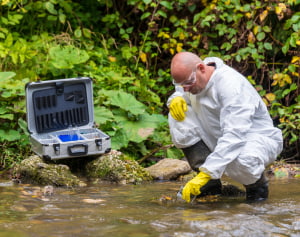Overview of Camp Lejeune Water Contamination

In the early 1980s, military chemists and a state-certified laboratory in North Carolina found volatile organic compounds (VOCs) in two of Camp Lejeune’s eight water treatment plants – Tarawa Terrace and Hadnot Point.
Since the late 1980s, the Agency for Toxic Substances and Disease Registry (ATSDR) has assessed Camp Lejeune’s water for health risks. Federal reports indicate the base water posed risks to everyone on the base, especially those who spent at least 30 days there between 1953 and 1987.
The ATSDR’s research and numerous other studies have shown that people who lived or worked on the base during this time are at risk of developing multiple forms of Camp Lejeune cancer, birth defects, and other serious health conditions.
With people sick and dying from unexplainable conditions, victims and their loved ones were left wondering for decades about what happened at Camp Lejeune.
Finally, thanks to the Camp Lejeune Justice Act (CLJA) of 2022, water contamination victims can access financial compensation. However, you only have until August 2024 to take action, so don’t wait.
Is the Government to Blame for Camp Lejeune Water Contamination?
Yes. The federal government, the United States military, and a privately owned dry cleaner each contributed to (or hid) the contaminated groundwater near Tarawa Terrace and Hadnot Point.
- Burn and drum dumps
- Former fire training area
- Fuel tank sludge area
- Industrial fly-ash dump
- Liquid disposal area
- Off-base private dry cleaner
- Open storage pit
- Original base dump
- Transformer storage lot
How Did Camp Lejeune Toxic Water Mix Into Clean Water?
The two water supply wells at Camp Lejeune collected and pumped the contaminated groundwater into a treatment plant. Since the military cycled the eight wells at Camp Lejeune (alternating from one well to another), only a few would pump water at any given time.
Whenever the two contaminated wells were in operation, they pumped the toxic water into the treatment plants, mixing it with clean water from the uncontaminated wells before being delivered to the base.
Because of this, the harmful chemicals in the water varied during the decades-long contamination period. Alarmingly, the ATSDR’s research found that both short- and long-term exposure to the chemicals in Camp Lejeune’s water increases the risk of numerous health conditions.
Camp Lejeune Water Contamination Illnesses
Research shows that people who lived or worked at Camp Lejeune when the water was contaminated are at greater risk of developing many different health conditions.
- Amyotrophic lateral sclerosis (ALS), also known as Lou Gehrig’s disease
- Aplastic anemia and other myelodysplastic syndromes
- Birth defects
- Bladder cancer
- Breast cancer (in women and men)
- Cervical cancer
- Colorectal cancer
- Crohn’s disease
- Esophageal cancer
- Female infertility & miscarriage
- Heart disease
- Hepatic steatosis (fatty liver)
- Hodgkin’s lymphoma
- Kidney cancer
- Leukemia
- Liver cancer
- Lung cancer
- Lymphomas
- Multiple myeloma
- Neurological disorders
- Non-Hodgkin’s lymphoma
- Pancreatic cancer
- Parkinson’s disease
- Prostate cancer
- Rectal cancer
- Renal toxicity
- Sarcoma
- Scleroderma
Unfortunately, there may be even more medical issues linked with the water not listed. If you or a loved one developed a health condition from water contamination at Camp Lejeune, you may finally be able to access financial compensation from the government.
Camp Lejeune Water Contamination Deaths
If you lost a loved one due to the polluted water, you may be eligible to file a Camp Lejeune wrongful death lawsuit on their behalf. Even if they passed away decades ago, you may have new rights.
Those who lived or worked at Camp Lejeune when the water was actively contaminated are more likely to die from certain cancers or Lou Gehrig’s disease, also known as amyotrophic lateral sclerosis (ALS), according to a study conducted by the Centers for Disease Control and Prevention (CDC) and published in the medical journal Environmental Health.
The study compared 150,000 Marines stationed at Camp Lejeune from 1975 to 1985 with 150,000 Marines stationed at Camp Pendleton in California during that same time.
- Roughly 10% greater risk of dying from cancer
- 35% higher risk of kidney cancer
- 42% higher risk of liver cancer
- 47% higher risk of Hodgkin’s lymphoma
- Double the risk of ALS if exposed to vinyl chloride
For many families, understanding where to begin looking for answers about their loved one’s death can be challenging. The first step is to find out if your loved one served at Camp Lejeune. This step is vital in determining your eligibility to pursue a claim.
RELATED: Find Out If Your Family Member Was at Camp Lejeune
Camp Lejeune Toxic Water Symptoms
While specific Camp Lejeune toxic water symptoms vary depending on the illness, behavioral changes and cognitive impairment are among the potential early warning signs of exposure to Camp Lejeune water contamination.
- Confusion
- Cramping
- Depression
- Diarrhea
- Dizziness
- Fatigue
- Fever or chills
- Headaches
- Lack of coordination
- Light sensitivity
- Nausea
- Numbness in limbs
- Swollen lymph nodes
- Trouble concentrating
- Vomiting
Talk with your doctor if you have any of these symptoms, as they can be signs of more serious conditions. Don’t forget to tell them about the time you spent on base to ensure you get a prompt and proper diagnosis.
Who Are the Victims of Camp Lejeune Water Contamination?
Camp Lejeune water contamination victims include Marines, civilian workers, and their families. Sadly, enlisted families — including infants and children — and younger, unmarried service personnel living in residential areas served by these two water systems were the main victims of Camp Lejeune water contamination.
Babies whose mothers were exposed to Camp Lejeune water during pregnancy were at increased risk for certain birth defects, multiple types of cancer, and neural tube defects.
“Marines have complained they and their children suffered cancer, including breast cancer and fatal leukemia, because of the contamination.”
–NBC News
Additionally, anyone who visited the base for a total of 30 days or more could be at risk, even if the days were not back-to-back.
Although many Camp Lejeune victims have faced decades of frustrating denials by the U.S. Department of Veterans Affairs (VA) while also battling serious health conditions, they may finally be able to get the money they are owed thanks to the CLJA (part of the PACT Act).
Camp Lejeune Water Contamination Risk Factors
Camp Lejeune water contamination risk factors vary, with Marines facing the highest risk due to their high water consumption and exposure during training exercises.
“A Marine in training under warm weather conditions could drink between one and two quarts of water per hour. Combining this ingestion rate with dermal and inhalation exposures from showering twice a day, a Marine could consume a liter-equivalent of up to eight liters of drinking water per day.”
–Environmental Health
Another important risk factor is how the toxic water exposure occurred, including:
- Drinking the water
- Bathing or coming into contact with the water through the skin
- Inhaling the water’s chemicals while bathing or dishwashing
- Swimming in the water during training exercises or recreation
Sadly, some studies suggest pregnant women and young children were at especially high risk for illness. This is because the presence of contaminants in drinking water can cause serious complications for expecting mothers, such as miscarriage. Birth defects and even fetal death can occur in developing babies.
If you or a loved one has experienced health issues or illnesses that could be linked to Camp Lejeune toxic water, working with a skilled Camp Lejeune water lawyer is the best way to understand what options may be available to you.
When Was Camp Lejeune’s Water Contaminated?
The drinking water at Camp Lejeune was contaminated from the 1950s through the 1980s, according to the ATSDR. Anyone who lived or worked on the base during this time may have been exposed.
Camp Lejeune Founded
Camp Lejeune residents are exposed to toxic chemicals in the water supply
Since families lived on the base, this included pregnant women, infants, and children. Anyone born up until the mid-1980s could still be at risk today.
Fortunately, the CLJA (part of the PACT Act) allows eligible victims to pursue a Camp Lejeune claim, no matter how long ago they were exposed.
Chemicals in Camp Lejeune Toxic Water
Camp Lejeune contaminated water was caused by VOCs released into the groundwater and pumped into the base through the Tarawa Terrace and Hadnot Point wells.
- Benzene
- Dichloroethylene (DCE)
- Tetrachloroethylene – also known as perchloroethylene (PCE)
- Trichloroethylene (TCE)
- Vinyl chloride
- Other contaminants
Tarawa Terrace Water Contamination
The primary contaminant believed to be present at Tarawa Terrace is PCE. People who lived or worked at Tarawa Terrace between 1957 and 1985 were exposed to water with PCE concentrations well above the U.S. Environmental Protection Agency’s (EPA) maximum contaminant level.
Hadnot Point Water Contamination
The origin of Hadnot Point’s contamination is believed to be more complicated since multiple sources and chemicals were involved.
TCE is thought to be the primary contaminant, but other chemicals were also present, especially from 1953 to 1985. The Hadnot Point water supply is considered far more contaminated than Tarawa Terrace.
Even if you’re unsure where you or your loved one lived or worked at Camp Lejeune, don’t hesitate to contact us. Our skilled Camp Lejeune claims advocates will listen to your story and help you pursue compensation if you have a claim. Connect with us right now.
Payouts: How to File a Claim for Camp Lejeune Water Contamination
Camp Lejeune victims have multiple avenues to seek compensation for harm caused by the toxic water, including VA benefits and several legal options.
Learn how to file a claim for Camp Lejeune water contamination below.
Camp Lejeune Veterans Benefits
Camp Lejeune VA benefits are available to eligible veterans and family members who lived or worked at Camp Lejeune or Marine Corps Air Station (MCAS) New River.
To get VA benefits, veterans and their family members must show evidence that they:
- Lived on the base for 30+ days between August 1, 1953, and December 31, 1987, or have a dependent relationship with a veteran who served at Camp Lejeune during this time
- Paid health care expenses for a covered condition within the designated date ranges
- Were not dishonorably discharged
While Camp Lejeune VA benefits and support have provided some relief to those affected, many feel they were not enough. Others have faced service connection denials, locking them out of receiving the disability benefits they desperately need.
Elective Option
 The voluntary Elective Option (EO) is a fast-tracked payout option developed by the Navy and the Justice Department. It is available to Camp Lejeune victims with specific diagnoses and aims to streamline payouts and resolve claims faster than the standard Camp Lejeune settlement timeline.
The voluntary Elective Option (EO) is a fast-tracked payout option developed by the Navy and the Justice Department. It is available to Camp Lejeune victims with specific diagnoses and aims to streamline payouts and resolve claims faster than the standard Camp Lejeune settlement timeline.
EO settlements are based on tiered payouts ranging from $100,000 to $550,000. However, many families and legal experts believe these amounts might be substantially less than what could be awarded from Camp Lejeune lawsuits.
Lawsuits & Settlements
With the passing of the PACT Act, victims of the water contamination are finally able to pursue Camp Lejeune lawsuits against the government.
The lawsuit process begins by filing an administrative claim with the Navy’s Judge Advocate General’s Corps (JAG) detailing the harm caused by the base’s contaminated water. The JAG has 180 days to respond.
If you do not hear back before the 180 days are up, or you are not satisfied with the decision, you can then file a lawsuit to pursue compensation through a Camp Lejeune settlement or verdict.
The federal government has set aside over $21 billion to compensate Camp Lejeune victims and their families.
Importantly for veterans, this money does not come from the VA — it is in addition to any current or future VA benefits. Even veterans whose claims were denied in the past may be newly eligible.
Remember, you only have until August 10, 2024, to take action under the CLJA. By working with an experienced Camp Lejeune lawyer, you can ensure your claim is filed on time while maximizing the payout your family receives.
Download our FREE Attorney Checklist for help choosing the best Camp Lejeune lawyer. Having the right legal partner on your side is key to the outcome of your case.
Help for Camp Lejeune Toxic Water Victims and Families
Camp Lejeune toxic water survivors have been fighting for decades to get justice. After the tireless efforts of victims, family members, and advocates, the time has finally come.
If you or a loved one lived or worked at Camp Lejeune for at least 30 days between 1953 and 1987, the Camp Lejeune Justice Act may entitle you to financial compensation. Even if the exposure happened decades ago, it is not too late to pursue justice.
The Camp Lejeune Claims Center can connect eligible victims with qualified lawyers with the experience and resources to seek maximum Camp Lejeune compensation.
As of July 2024, our legal partners have already helped over 30,000 families with their Camp Lejeune claims.
Camp Lejeune Water Contamination FAQs
What caused the contaminated water in Camp Lejeune?
Camp Lejeune water contamination was caused by two water supply systems – Tarawa Terrace and Hadnot Point. The wells in these systems collected contaminated groundwater and pumped it into the treatment plant that supplied water to the base.
How did the water get contaminated in Camp Lejeune?
The water at Camp Lejeune got contaminated when two of the base’s water supply wells, contaminated with harmful chemicals, were used in rotation with other wells.
As a result, whenever these contaminated wells were active, they pumped toxic water into the treatment plants, mixing it with clean water from the other wells.
This led to varying concentrations of dangerous chemicals in the base’s water supply over several decades.
What was in the water at Camp Lejeune?
Camp Lejeune’s water was contaminated with volatile organic compounds (VOCs), according to a federal public health agency called the Agency for Toxic Substances and Disease Registry (ATSDR).
VOCs have high vapor pressure and low water solubility. Many VOCs are manmade and are used to make industrial solvents, degreasers, petroleum fuels, hydraulic fluids, paint thinners, and dry cleaning agents. They are common groundwater contaminants and are known to cause severe health effects.
What chemicals were in the water at Camp Lejeune?
The Agency for Toxic Substances and Disease Registry (ATSDR) reported that Camp Lejeune’s water was contaminated with:
- Benzene
- Dichloroethylene (DCE)
- Tetrachloroethylene (PCE)
- Trichloroethylene (TCE)
- Vinyl chloride
Many of the toxic substances that contaminated the water at Camp Lejeune are carcinogenic, meaning they’re known to cause cancer.
When was Camp Lejeune water contaminated?
The base water at Camp Lejeune was contaminated from the 1950s through the 1980s, according to the U.S. Department of Veterans Affairs (VA).
Is Camp Lejeune water still contaminated?
No. The drinking water at Camp Lejeune is now safe. According to the official website of the U.S. Marine Corps, the water meets all drinking water requirements set by the government. Additionally, the water is tested more frequently than the government requires.
How can I file a Camp Lejeune water contamination claim?
The PACT Act of 2022 allows Camp Lejeune toxic water victims to file a claim, even if they were denied in the past or exposed decades ago. It’s not too late to file a claim for Camp Lejeune water contamination.
